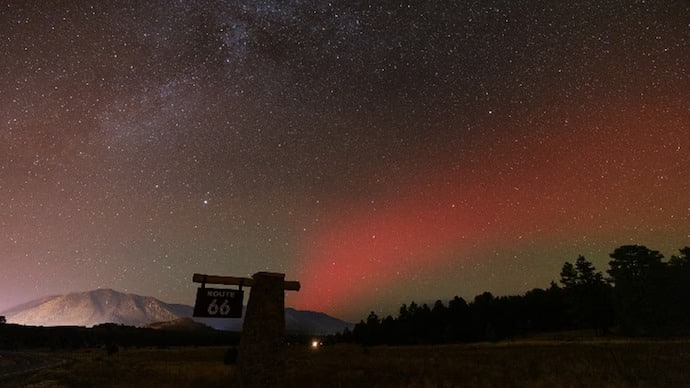About Stable Auroral Arc
- It is a rare atmospheric phenomenon which was observed during a strong G3-class geomagnetic storm.
- Unlike auroras, which occur when charged particles from space hit the atmosphere causing it to glow, SAR arcs form differently.
- They are an indication of heat energy leaking into the upper atmosphere from Earth’s ring current system, a donut-shaped circuit carrying millions of amps around our planet.
- During the recent geomagnetic storm, the ring current was energised by hours of intense geomagnetic activity, with energy dissipating into these SAR arcs.
- This global event was registered in many parts of the world.
How does Aurora form?
- It is formed when the sun is ejecting charged particles from its corona, creating solar wind. When that wind slams into Earth’s ionosphere, the aurora is born.
- In the Northern Hemisphere, the phenomenon is called the northern lights (aurora borealis), while in the Southern Hemisphere, it’s called the southern lights (aurora australis).
- The hemispheric asymmetry of the aurora is due in part to the sun’s magnetic field interfering with Earth’s magnetic field.
Q1) What is ionosphere?
It is a region of Earth’s upper atmosphere, extending from about 48 kilometers to up to 600 kilometers above the Earth’s surface. It is a region where the atmosphere becomes ionized, meaning that the atoms and molecules in this part of the atmosphere lose or gain electrons, resulting in the presence of charged particles called ions.
Source: IIA’s observatory captures red-hued Aurora from Hanle, Merak
Last updated on December, 2025
→ Check out the latest UPSC Syllabus 2026 here.
→ Join Vajiram & Ravi’s Interview Guidance Programme for expert help to crack your final UPSC stage.
→ UPSC Mains Result 2025 is now out.
→ UPSC Notification 2026 is scheduled to be released on January 14, 2026.
→ UPSC Calendar 2026 is released on 15th May, 2025.
→ The UPSC Vacancy 2025 were released 1129, out of which 979 were for UPSC CSE and remaining 150 are for UPSC IFoS.
→ UPSC Prelims 2026 will be conducted on 24th May, 2026 & UPSC Mains 2026 will be conducted on 21st August 2026.
→ The UPSC Selection Process is of 3 stages-Prelims, Mains and Interview.
→ UPSC Result 2024 is released with latest UPSC Marksheet 2024. Check Now!
→ UPSC Prelims Result 2025 is out now for the CSE held on 25 May 2025.
→ UPSC Toppers List 2024 is released now. Shakti Dubey is UPSC AIR 1 2024 Topper.
→ UPSC Prelims Question Paper 2025 and Unofficial Prelims Answer Key 2025 are available now.
→ UPSC Mains Question Paper 2025 is out for Essay, GS 1, 2, 3 & GS 4.
→ UPSC Mains Indian Language Question Paper 2025 is now out.
→ UPSC Mains Optional Question Paper 2025 is now out.
→ Also check Best IAS Coaching in Delhi

















